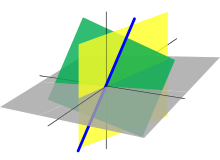Straight line through the origin
In mathematics, a straight line through the origin is a straight line that runs through the coordinate origin of a given Cartesian coordinate system . Therefore straight lines through the origin are described by particularly simple straight line equations . The position vectors of the points of a straight line through the origin form a one-dimensional sub - vector space of Euclidean space .
Straight line through the origin in the plane
definition
A straight line through the origin in the Euclidean plane is a straight line that passes through the origin of the coordinate system. In the coordinate form , a straight line through the origin consists of those points on the plane whose coordinates correspond to the straight line equation
where and are parameters that cannot both be zero. By solving this equation , one obtains the simpler form , provided that is
with the slope . In this form, however, a straight line through the origin cannot run perpendicular to the x-axis.
Examples
Important examples of straight lines through the origin are the two coordinate axes with the straight line equations
- and .
Other important examples of straight lines through the origin are the bisectors of the I. and III. as well as the II. and IV. quadrants with the straight line equations
- and .
Vector equations
Straight lines through the origin can also be described by vector equations . In parametric form , a straight line through the origin then consists of those points on the plane whose position vectors correspond to the equation
for meet. The position vectors of the points of a straight line through the origin are therefore scalar multiples of the direction vector . Alternatively, a straight line through the origin can also be in normal form using the normal equation
can be specified. Here represents a normal vector of the straight line and the scalar product of the two vectors and . A straight line through the origin then consists of those points of the plane whose position vectors are perpendicular to the given normal vector.
Plumb line
For each straight line through the origin there is a perpendicular straight line which also runs through the origin of the coordinates. This perpendicular line then has the coordinate representation
or, if the slope of the starting line is,
- .
A normal vector of the starting line is a direction vector of the perpendicular line and a direction vector of the starting line is a normal vector of the perpendicular line.
Straight line through the origin in space
definition
Vector equations can also be used to describe straight lines through the origin in higher-dimensional Euclidean spaces . In parametric form, a straight line through the origin with a direction vector then consists of those points in space whose position vectors give the equation
for meet. As in the two-dimensional case, a straight line through the origin consists of all points in space whose position vectors are a scalar multiple of the directional vector of the straight line. However, a normal equation no longer describes a straight line in three-dimensional and higher-dimensional spaces, but a hyperplane .
Examples
In three-dimensional space, the three coordinate axes can be represented by the straight line equations
- and
to be specified. Where , and are the three standard unit vectors .
Distance of a point
The distance between a point with a position vector and a straight line through the origin with a direction vector is , where
is the position vector of the plumb line , i.e. the orthogonal projection of the vector onto the straight line.
Vector space structure
The vectors in Euclidean space form a vector space , the so-called coordinate space . The set of position vectors of the points of a straight line through the origin forms a sub-vector space of Euclidean space
- .
This sub-vector space is precisely the linear envelope of the direction vector of the straight line. The straight lines through the origin are the only one-dimensional sub - vector spaces of Euclidean space.
Straight line through the origin as a section
The two-dimensional subspaces of the three-dimensional Euclidean space are precisely the planes of origin . The intersection of two different planes of origin always results in a straight line through the origin, the direction vector of this straight line through the cross product
the normal vectors and the two planes of origin is given. In general, the -dimensional sub-vector spaces in the -dimensional Euclidean space are original hyperplanes and the intersection of such hyperplanes with linearly independent normal vectors always results in a straight line through the origin, the direction of which is given by the generalized cross product
given is.
See also
literature
- Kenneth Eriksson, Donald Estep, Claes Johnson: Applied Mathematics: Body and Soul 1 . Springer, 2006, ISBN 3-540-35006-3 .
- Mike Scherfner, Torsten Volland: Mathematics for the first semester . Springer, 2012, ISBN 3-8274-2505-0 .












































